|
|
Butterflies - Gossamer-wing -
More Information
|
|
|
~ Click on any image for an enlargement - scrollable if it is too big for browser window ~
|
|
Kingdom: Animalia
Phylum: Arthropoda
Subphylum: Hexapoda
Class: Insecta Pterygota
Order: Lepidoptera
Family: Gossamer-wing Lycaenidae
Subfamilies: Blues Polyommatinae - Hairstreaks Theclinae
Family Description: The Lycaenidae are members of the Superfamily Papilionoidea, the true butterflies. Worldwide in distribution, this family has approximately 4,700 species that are unevenly distributed. Coppers are especially dominant in north temperate regions, blues are richest in the Old World tropics and north temperate zones, and hairstreaks are particularly abundant in New World tropics. The adults are typically small to tiny and often brilliantly colored--iridescent blues, bright reds, and oranges. Adults of both sexes have three pairs of walking legs, though most males have fused segments in their front legs. Most adults visit flowers for nectar, but some harvesters feed on wooly aphid honeydew and some hairstreaks feed on aphid honeydew or bird droppings. Females lay single, sea urchin shaped eggs on host leaves or flower buds; the resulting caterpillars are typically slug-shaped. In many species, caterpillars depend on ants for protection, so caterpillars produce sugary secretions that are collected by the ants. Most species overwinter in either the egg or pupal stage.
Subfamily Description: Blues are tiny to small butterflies of the Family Lycaenidae. Distributed worldwide, they are most diverse in Southeast Asia, tropical Africa, and northern temperate regions. Most of the nearly 50 North American species are found in the west. Adult males are predominantly blue above, due to reflected light rather than pigmentation. Some males and most females are largely brown above. Below, wings of both sexes are usually gray-white with black spots or streaks. Adults in some genera (Euphilotes, Lycaeides, Plebulina, and Icaricia) have more or less prominent orange submarginal bands on their hindwings. Most adults are found near their host plants, and they do not fly long distances, though some tropical and subtropical species undertake long migrations. Adults visit flowers for nectar. Males frequent moist sand and mud, and females lay eggs singly on host plant leaves or flowers. As caterpillars, they secrete sugary secretions that attract ants, and caterpillars of some species are raised in ant nests. Blues usually overwinter in the pupal stage.
Subfamily Description: Hairstreaks are members of the Family Lycaenidae. Richest in tropical habitats, hairstreaks are numerous in the Americas and comprise about 1,000 species. In tropical species, the upperside of small to medium-sized adults is often iridescent blue, due to reflected light from the wing scales. However, most of the North American species are brown above. Migration is rare, but a few species (such as the Gray Hairstreak) are good long-distance colonists. Males perch to await mates, and females lay eggs singly. Caterpillars usually feed on leaves or reproductive structures of woody trees or shrubs. Interestingly, the chrysalids of several species can produce sounds between their abdominal segments, likely related to their interactions with ants. Hairstreaks typically overwinter in the egg or pupal stage.
|
Ceraunus Blue
Eastern Tailed-blue |
Gray Hairstreak
Oak (Northern) Hairstreak |
Red-banded Hairstreak
Spring Azure
Striped Haristreak
Summer Azure
|
Ceraunus Blue Butterfly
Subfamily: Polyommatinae
Hemiargus ceraunus 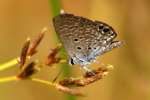 |
- Identification: Upperside of male light blue with a darker narrow border; female dark brown, often with wing bases blue. Underside gray; both wings with a row of dark postmedian dashes. Florida butterflies have one submarginal eyespot on hindwing; Southwest butterflies have two.
- Life history: Males patrol during warm hours of the day for receptive females. Eggs are laid singly on flower buds or leaves of host plant; caterpillars feed on flowers and seedpods.
- Flight: Throughout the year in Texas and south Florida, late summer in other parts of its range.
- Wing span: 3/4 - 1 1/8 inches (2 - 3 cm).
- Caterpillar hosts: A variety of woody legumes including partridge pea (Cassia brachiata), mesquite (Prosopis species), and rosary pea (Abrus precatorius).
- Adult food: Flower nectar.
- Habitat: Open woodland, desert scrub, dunes, pastures, road edges, and vacant lots.
- Range: U. S. Southwest, South Texas, Florida and the Keys south through the West Indies, Mexico, and Central America to South America. Strays to North Carolina, Missouri, Kansas, and Nevada.

|
|
Eastern Tailed-Blue Butterfly
Subfamily: Polyommatinae
Everes comyntas
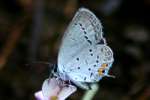
|
- Identification: One narrow tail on hindwing. Upperside of male iridescent blue; summer females uniformly brown, spring females smaller with much blue at the wing bases. Underside of hindwing pale gray with black bar at end of cell, distinct black spots, and three large orange spots at outer margin near tail.
- Life history: Males patrol near the host plants during daylight hours. Females lay eggs on flower buds; caterpillars eat buds, flowers, and seeds. The caterpillar hibernates, pupating the following spring. Although most Lycaenids do not perch with open wings, Eastern Tailed-Blues sometimes bask with their wings at a 45 angle.
- Flight: Three broods from April-November in the north, many broods from February-November in the south.
- Wing span: 7/8 - 1 1/8 inches (2.2 - 2.9 cm).
- Caterpillar hosts: Many plants in the pea family including yellow sweet clover (Melilotus officinalis), alfalfa (Medicago sativa); various species of vetch (Vicia), clover (Trifolium), wild pea (Lathyrus), and bush clover (Lespedeza); and others.
- Adult food: This butterfly has a low flight and a short proboscis, thus is found at flowers close to the ground which are open or short-tubed. These include white sweet clover, shepherd's needle, wild strawberry, winter cress, cinquefoils, asters, and others.
- Habitat: Many open, sunny places including weedy areas and disturbed habitats.
- Range: Southeast Canada and Eastern United States west to western North Dakota, central Colorado, and central Texas. Also ranges from southeastern Arizona, western New Mexico, and west Texas south to Costa Rica.

|
Gray Hairstreak Butterfly
Subfamily: Theclinae
Strymon melinus
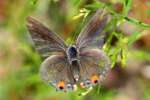
|
- Identification: One tail on hindwing. Upperside blue-gray with large red spot near tail. Underside of spring/fall form is dark gray, summer form is paler gray. Relatively straight postmedian line is white, bordered with orange on the inside edge.
- Life history: Males perch all afternoon on small trees and shrubs to seek receptive females. Eggs are laid singly on flowers of host plant. Young caterpillars feed on flowers and fruits; older ones may eat leaves. Chrysalids hibernate.
- Flight: Two flights from May-September in the north, three-four flights from February-November in the south.
- Wing span: 7/8 - 1 3/8 inches (2.2 - 3.5 cm).
- Caterpillar hosts: Flowers and fruits from an almost endless variety of plants; most often from pea (Fabaceae) and mallow (Malvaceae) families including beans (Phaseolus), clovers (Trifolium), cotton (Gossypium), and mallow (Malva).
- Adult food: Nectar from many flower species including dogbane, milkweed, mint, winter cress, goldenrod, tick trefoil, and white sweet clover.
- Habitat: Open, nonforested sites; common in disturbed, weedy areas.
- Range: Throughout continental United States from southern Canada south to Mexico; southward to Venezuela. Comments: The most widespread hairstreak in North America.

|
Oak (Northern) Hairstreak Butterfly
Subfamily: Theclinae
Satyrium favonius ontario
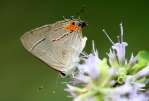 |
- Identification: Two tails on each hindwing. Underside of hindwing gray-brown; blue tail-spot capped narrowly with orange; white-edged black W near inner margin. In peninsular Florida and along the south Atlantic coast, the hindwing has longer tails and more extensive orange and blue markings on the underside.
- Life history: Eggs are laid singly on host plant twigs and hatch the following spring. Caterpillars feed on leaves, buds, and male catkins
- Flight: One flight from March-June.
- Wing span: 7/8 - 1 1/2 inches (2.2 - 3.8 cm).
- Caterpillar hosts: Various oaks (Quercus species).
- Adult food: Flower nectar.
- Habitat: Oak woodlands and edges, oak hammocks in the Deep South.
- Range: Southern New England and the Atlantic Coast south to peninsular Florida; west to central Illinois, southeastern Colorado, and the Gulf Coast.

|
Red-banded Hairstreak Butterfly
Subfamily: Theclinae
Calycopis cecrops
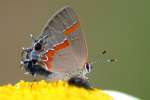 |
- Identification: Two tails on the hindwing. Upperside brown, hindwing blue. Underside gray-brown with white postmedian line edged with red-orange.
- Life history: Males perch on shrubs and low trees to watch for females. Females lay eggs singly on underside of fallen leaves near the host plant. Caterpillars feed on leaves and buds and probably detritus. Chrysalids and fourth-stage caterpillars hibernate.
- Flight: All year in Florida, two broods northward from April-October.
- Wing span: 7/8 - 1 1/4 inches (2.2 - 3.2 cm).
- Caterpillar hosts: Fallen leaves of wax myrtle (Myrica cerifera), dwarf sumac (Rhus copallina), staghorn sumac (R. typhina), and several oaks.
- Adult food: Flower nectar from yarrow, wild cherry, tickseed sunflower, sumac, sweet pepperbush, New Jersey tea, common milkweed, and dogbane.
- Habitat: Coastal hammocks, overgrown fields, forest edges.
- Range: Southeastern United States from Long Island south through Florida, west through entire area to southeast Kansas, eastern Oklahoma, and eastern Texas. Strays to eastern Nebraska, northern Illinois, and Michigan.

|
Spring Azure Butterfly
Subfamily: Polyommatinae
Celastrina ladon
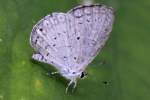
|
- Identification: Seasonally variable and sexually dimorphic. Upperside of males blue, females with some black at outer edge of forewing. Late spring and summer forms with white above. Underside hindwing gray-white with faded small black dots, darker gray with larger black spots, or with blotches and black margins in the center.
- Life history: Males patrol and perch all day but are most active from midafternoon until dusk. Eggs are laid on flower buds. Caterpillars feed on flowers and fruits and are tended by ants. Chrysalids hibernate.
- Flight: Many broods from January-October along the Gulf Coast; progressively shorter flights northward; May-August in Canada.
- Wing span: 7/8 - 1 3/8 inches (2.2 -3.5 cm).
- Caterpillar hosts: Flowers of a variety of woody shrubs and occasionally herbs including dogwood (Cornus florida), New Jersey tea (Ceanothus americana), meadowsweet (Spiraea salicifolia), and Collinsia.
- Adult food: Flower nectar from dogbane, privet, New Jersey tea, blackberry, common milkweed, and many others.
- Habitat: Openings and edges of deciduous woods, old fields, wooded freshwater marshes and swamps.
- Range: Alaska and Canada south of the tundra through most of the United States except the Texas coast, southern plains, and peninsular Florida; south in the mountains to Columbia.

|
Striped Hairstreak
Subfamily: Theclinae
Satyrium liparops
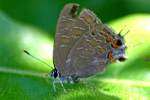 |
- Identification: Hindwing with 1 long and 1 short tail. Upperside dark brown; male with a long, oval spot along forewing costa. Underside of both wings with rows of widely separated white stripes; blue spot near tails topped with orange. Outer margin of hindwing indented above short tail.
- Life history: Males perch on foliage within 6 feet of the ground to watch for females. Eggs are laid singly on twigs of host plants and hatch the following spring. Caterpillars feed on buds, leaves, flowers, and young fruit.
- Flight: One flight from July-August in the north, May in the south.
- Wing span: 1 - 1 1/2 inches (2.5 - 3.9 cm).
- Caterpillar hosts: Several woody trees and shrubs in the rose (Rosaceae) family including American plum; and heath (Ericaceae) family; also reports for hornbeam, oak, and willow.
- Adult food: Nectar from chinquapin, common milkweed, dogbane, goldenrod, meadowsweet, New Jersey tea, staghorn sumac, viburnum, and white sweet clover.
- Habitat: Deciduous forest openings and edges, prairie streamsides, shaded swamps, acid barrens, prairie copses.
- Range: Local, not abundant in its range. Rocky Mountains south from southern Canada to Colorado, east to Maine, south to Florida.

|
Summer Azure Butterfly
Subfamily: Polyommatinae
Celastrina neglecta
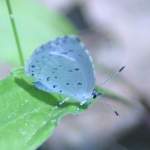 |
- Identification: Upperside of male powdery blue often with ill-defined white patch on hindwing. Female with much white scaling on both forewings and hindwings. Underside of hindwing pale gray or white with small black dots and submarginal dark zigzag line.
- Life history: Caterpillars eat flowers. Chrysalids overwinter until flower late spring or summer.
- Flight: One flight from June to October.
- Wing span: 15/16 - 1 1/8 inches (2.4 - 2.9 cm).
- Caterpillar hosts: Racemose dogwood, New Jersey Tea, and other plants.
- Adult food: Flower nectar.
- Habitat: Various habitats including stream valleys, powerline right-of-ways, gardens.
- Range: Most of eastern and central United States as well as southern Canada.

|
| Information / Identification Sources: |
For identification our primary reference is Butterflies of North America - Kaufman Focus Guides - by Jim P. Brock & Ken Kaufman. We also use internet sources when in question - typically BugGuide and Jeff's Butterfly Page. Our text information (above) comes from Butterflies & Moths of North America. |
|


